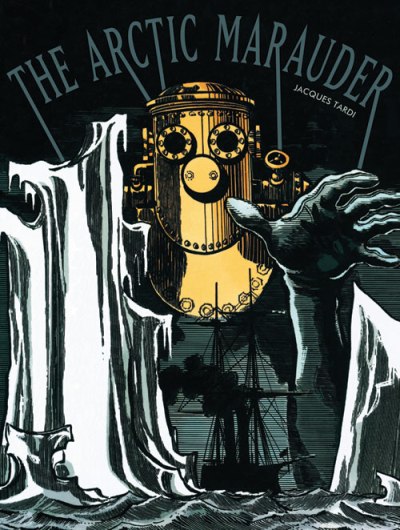The Arctic Marauder
Reviewed by Peter Campbell 09-May-11
Fantagraphics continues its programme of issuing the works of Jacques Tardi with this, a translation of a comic from the earliest stages of his career. It’s a slim volume (64 pages), written and drawn in a style that reveals another facet to his diverse abilities. It’s also the least satisfying of his works to appear in English to date.
Fantagraphics continues its programme of issuing the works of Jacques Tardi with this, a translation of a comic from the earliest stages of his career. It’s a slim volume (64 pages), written and drawn in a style that reveals another facet to his diverse abilities. It’s also the least satisfying of his works to appear in English to date.
It’s a strange creation. Jerome Plumier is on a ship sailing in arctic waters, which comes across another ship stranded high on top of an iceberg. While the crew investigate this discovery (with its frozen solid crew, the petrified captain pointing to a specific location on a map) their own ship explodes. This is the start of trail that leads Plumier to the house of his apparently deceased uncle, onwards through Europe, and back to the arctic again, where he encounters sea monsters, elaborate underwater contraptions and a plot to destroy the world.
This is Tardi as parodist. The plot and characters are deliberately over the top. There are long, purple passages of dialogue and text that threaten to crowd out the artwork in some panels. The plot clunks along with absurd twists and random plot justifications, threads thrown in at what seem random intervals, and is brought to a conclusion in melodramatic fashion. In a setting like this there’s never going to be any chance the characters are going to be more than ciphers, and so we have the Mad Scientist. Oh, and a second Mad Scientist. And the Mysterious Woman. And the Dedicated Nephew, who follows the trail of clues that leads to his uncle’s lair. This ought to be a lot more enjoyable than it actually is, but it’s a curiously thin and brittle work that mimics and exaggerates the conventions of the pulp fiction its draws on, but doesn’t go beyond that.
Writing about this book, Kim Thomson, who provides another fine translation, makes claim that this foreshadows the steampunk genre. It can certainly be viewed that way, the first in a line that leads on and beyond The League of Extraordinary Gentlemen, but it’s more accurately a parody of the works of Jules Verne, who similarly combined outlandish adventures with quasi science fiction trappings.
The saving grace here is the artwork. The backgrounds resemble engravings, or the elaborate, detailed illustrations that adorned melodramatic Victorian novels and, later, pulp magazines. Set against this are Tardi’s characters, more obviously cartoon-like in appearance, very much a template for the figures in his later comics: whippet thin, wearing bemused expressions, caught somewhere between caricature and realism. It looks gorgeous, but even so there are difficulties. The intensity of detail, especially when combined with the cumbersome text, becomes so dense that it loses narrative focus. And then there are the page layouts, artfully designed, with a structure that echoes Art Nouveau, with arching and circular panels that often echo each other. The problem is that, again, it halts narrative flow, with text curved around panels in way that sometimes makes it difficult to read. It’s form taking precedence over content, and while there’s nothing wrong with that, it’s only justifiable if it’s successfully carried out, which isn’t always the case here.
Essentially, this is a thin joke worn thinner still by repetition. Its interest lies in the knowledge that someday Tardi would produce masterpieces of the medium such as You Are Here and It Was the War of the Trenches. You read it, and catch glimpses of the style and technique that make those comics so great. By itself though, it’s an unsatisfying work, one that shows promise and obvious artistic abilities, but there’s not a great deal beyond that to recommend to the casual reader.
Tags: Fantagraphics, Jacques Tardi